

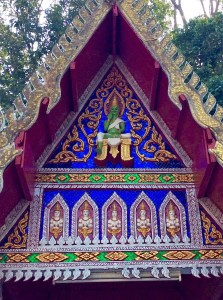 These Buddhist temples glitter like a fairground mirrors. Gold everywhere. They are fun – they’re holy but there’s also jolliness, unlike the basic sadness of Christianity and its churches. The roofs of the main vihara or preaching hall are orange edged with blackest blue and yellow tiles, and they are not straightforward; they look as if a smaller temple
These Buddhist temples glitter like a fairground mirrors. Gold everywhere. They are fun – they’re holy but there’s also jolliness, unlike the basic sadness of Christianity and its churches. The roofs of the main vihara or preaching hall are orange edged with blackest blue and yellow tiles, and they are not straightforward; they look as if a smaller temple  has been built over by a later temple, and then a further temple, all overlapping like a house of cards. This lets in the breeze but keeps out the rain? All traditional buildings have this complex format.
has been built over by a later temple, and then a further temple, all overlapping like a house of cards. This lets in the breeze but keeps out the rain? All traditional buildings have this complex format.
At the centre of the wat (temple) compound there’s usually a stupa, a solid dome or revetted pyramid built over a Buddha relic, which might be a single hair from his head. Sometimes, in the north, a series of 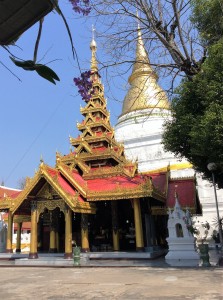 receding pagodas reach up, glittering in the sun. Cities and wats are orientated to the cardinal directions, whether somewhere like Chiang Mai, an ancient site like Sukothai or a wat. Different spirits try to enter, so there’s often a ledge, or a dog legged entrance, to prevent the bad ones getting in since these can only travel in a straight line.
receding pagodas reach up, glittering in the sun. Cities and wats are orientated to the cardinal directions, whether somewhere like Chiang Mai, an ancient site like Sukothai or a wat. Different spirits try to enter, so there’s often a ledge, or a dog legged entrance, to prevent the bad ones getting in since these can only travel in a straight line.
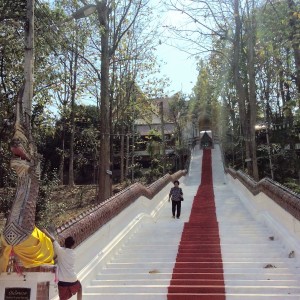 One temple near Phrae is on a hill reached by four flights of steps – cardinal directions of course – lined by long stone naga (snakes) guardians. (B took an elevator – I never saw where it was). You don’t just sit in this wat and listen to a boring sermon. In the compound you exchange a 20 baht note for a pail of pennies, and
One temple near Phrae is on a hill reached by four flights of steps – cardinal directions of course – lined by long stone naga (snakes) guardians. (B took an elevator – I never saw where it was). You don’t just sit in this wat and listen to a boring sermon. In the compound you exchange a 20 baht note for a pail of pennies, and 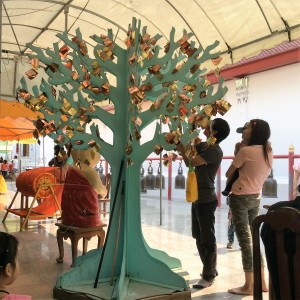 drop coins into a line of monks’ bowls. Tinkle tinkle tinkle. You write your wish on a copper tag and tie it to a tree, real or cut-out. Or you can buy a bell and attach it to a line of bells. (My bell is in the garden, and
drop coins into a line of monks’ bowls. Tinkle tinkle tinkle. You write your wish on a copper tag and tie it to a tree, real or cut-out. Or you can buy a bell and attach it to a line of bells. (My bell is in the garden, and 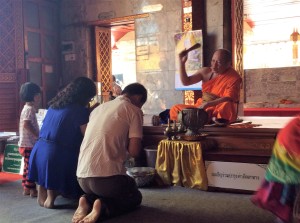 sometimes rings in the wind). Or you can write your name and message on a huge roll of orange cloth, in due course to be wound round the stupa. You can buy amulets, chains and the like, and I bought a ring with a mysterious symbol. What does it mean, I asked the woman. ‘It is lucky and happy’ she said. (Later looked it up on the web, and think it’s a protective parasol, warding off evil. It’s so pretty I wear it all the time). Or you can bring gifts for the monks. Shops sell buckets wrapped in orange cellophane holding goods like a torch, matches, soap, dried soup, joss sticks, bottled water, a tin of evaporated milk and a small plastic gold Buddha. Taking off your shoes, you enter the vihara to pray or be blessed by a monk. Where do you come from, asked the monk and when I replied he motioned me to kneel, dipped his whisk in a bowl of water and showered it several times over me, muttering magic words including ‘lucky lucky luck, happy happy happy’. (Somehow I was expecting something more high minded and less personal, like praying for world peace, refugees or whatever, but hell, I am not going to sniff at luck and happiness). On coming out I was satisfyingly damp with holy water.
sometimes rings in the wind). Or you can write your name and message on a huge roll of orange cloth, in due course to be wound round the stupa. You can buy amulets, chains and the like, and I bought a ring with a mysterious symbol. What does it mean, I asked the woman. ‘It is lucky and happy’ she said. (Later looked it up on the web, and think it’s a protective parasol, warding off evil. It’s so pretty I wear it all the time). Or you can bring gifts for the monks. Shops sell buckets wrapped in orange cellophane holding goods like a torch, matches, soap, dried soup, joss sticks, bottled water, a tin of evaporated milk and a small plastic gold Buddha. Taking off your shoes, you enter the vihara to pray or be blessed by a monk. Where do you come from, asked the monk and when I replied he motioned me to kneel, dipped his whisk in a bowl of water and showered it several times over me, muttering magic words including ‘lucky lucky luck, happy happy happy’. (Somehow I was expecting something more high minded and less personal, like praying for world peace, refugees or whatever, but hell, I am not going to sniff at luck and happiness). On coming out I was satisfyingly damp with holy water.
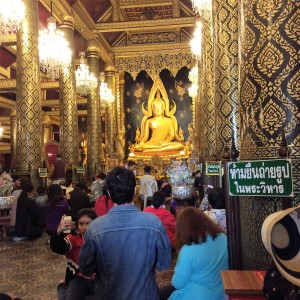 Some people take selfies backed by the Buddha (ok as long as you are kneeling) who like an altar and cross is the main focus. Inside huge fat pillars are painted in black diamonds like reticulated snakeskin. Sometimes strings, psychoducts, reach from the Buddha to the rest of the building, and even outside to carry his holiness beyond. Behind are painted trees, animals, water and mythic scenes, all set in the deer park, a sort of Buddhist garden of Eden, where the Buddha gained enlightenment. Walls are painted with myths and daily scenes; on one king Bhumibol and his queen are busy about their duties and uniformed soldiers stand in line. In one there’s the making of a bronze Buddha by the lost wax method. In another there’s a flying horse, and I’d love to know what it all meant. In a Sukothai temple the four rivers flow out of paradise into the world from a four lobed pool – as they flow in Muslim paradise gardens.
Some people take selfies backed by the Buddha (ok as long as you are kneeling) who like an altar and cross is the main focus. Inside huge fat pillars are painted in black diamonds like reticulated snakeskin. Sometimes strings, psychoducts, reach from the Buddha to the rest of the building, and even outside to carry his holiness beyond. Behind are painted trees, animals, water and mythic scenes, all set in the deer park, a sort of Buddhist garden of Eden, where the Buddha gained enlightenment. Walls are painted with myths and daily scenes; on one king Bhumibol and his queen are busy about their duties and uniformed soldiers stand in line. In one there’s the making of a bronze Buddha by the lost wax method. In another there’s a flying horse, and I’d love to know what it all meant. In a Sukothai temple the four rivers flow out of paradise into the world from a four lobed pool – as they flow in Muslim paradise gardens.
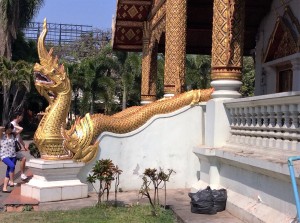 Wat steps are usually lined with guardian nagas, or reptiles like lizards or weird giant geckos. One rears up – her name in Thai and English is Mom – her mouth with gnashing teeth, a vagina dentata, glints with marbles.
Wat steps are usually lined with guardian nagas, or reptiles like lizards or weird giant geckos. One rears up – her name in Thai and English is Mom – her mouth with gnashing teeth, a vagina dentata, glints with marbles. 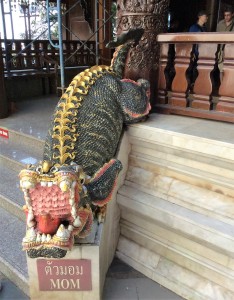 Fanged giants with swords stand by, sword in hand. Doughty little gnomes hold aloft a sill. I see a real tortoise, and here is a gold tortoise by the temple, with a coin in his mouth! Tortoise equals money. At the base of the Phrae temple hill and outside most temples stand a crowd of animals, usually in pairs, snakes, giraffes,
Fanged giants with swords stand by, sword in hand. Doughty little gnomes hold aloft a sill. I see a real tortoise, and here is a gold tortoise by the temple, with a coin in his mouth! Tortoise equals money. At the base of the Phrae temple hill and outside most temples stand a crowd of animals, usually in pairs, snakes, giraffes, 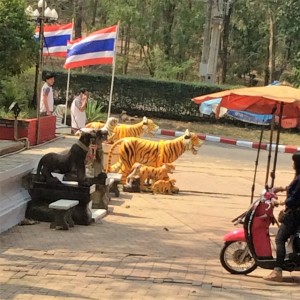 dragons and tigers and monkeys – from another garden of Eden, an Orphic idyll with animals at peace, a momentary lull when all creation is at one, still, quivering with a sense of its intricacy and mutual belonging – before back to the grabbing, greediness and fighting of daily life.
dragons and tigers and monkeys – from another garden of Eden, an Orphic idyll with animals at peace, a momentary lull when all creation is at one, still, quivering with a sense of its intricacy and mutual belonging – before back to the grabbing, greediness and fighting of daily life.
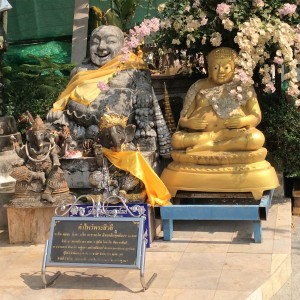 Statues of the Buddha everywhere, of course, loads of them, as well as Budai the ‘fat Buddha’ (in fact a Zen monk), and other bygone monks. Occasionally the goddess of mercy, and sometimes sexy Maya the goddess of water wringing her hair to produce rain, but otherwise – as with all religions – the statues are very
Statues of the Buddha everywhere, of course, loads of them, as well as Budai the ‘fat Buddha’ (in fact a Zen monk), and other bygone monks. Occasionally the goddess of mercy, and sometimes sexy Maya the goddess of water wringing her hair to produce rain, but otherwise – as with all religions – the statues are very 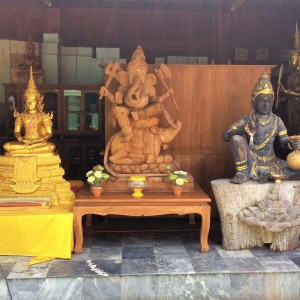 much male oriented. There are often Hindu gods, like Ganesh the elephant, and in the one Bangkok Hindu temple – much busier, but with a continual soothing mantra, all the better for its meaning being a mystery. Maidens came bearing bowls of fruit and flowers – I loved watching this primeval obeisance before the deity.
much male oriented. There are often Hindu gods, like Ganesh the elephant, and in the one Bangkok Hindu temple – much busier, but with a continual soothing mantra, all the better for its meaning being a mystery. Maidens came bearing bowls of fruit and flowers – I loved watching this primeval obeisance before the deity.
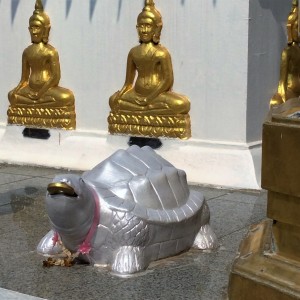 In towns nearly all buildings, not just houses but hotels, garages and banks, have their spirit houses, shaped like mini temples, to placate the spirits of the place. These can be regularly anointed with food, soft drinks, a carton of tofu milk, joss sticks and strings of flowers. Inside sit
In towns nearly all buildings, not just houses but hotels, garages and banks, have their spirit houses, shaped like mini temples, to placate the spirits of the place. These can be regularly anointed with food, soft drinks, a carton of tofu milk, joss sticks and strings of flowers. Inside sit 
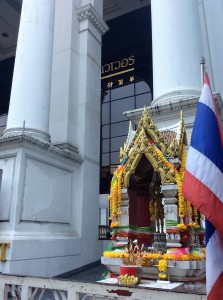 the ancestor guardians, including white haired granma with her specs, and on the ledge outside a menagerie of animals – animals in the garden of Eden again. Not many places for burial because it’s usually cremations. Some wats have rather stinking small crematoria, with tall chimneys.
the ancestor guardians, including white haired granma with her specs, and on the ledge outside a menagerie of animals – animals in the garden of Eden again. Not many places for burial because it’s usually cremations. Some wats have rather stinking small crematoria, with tall chimneys.
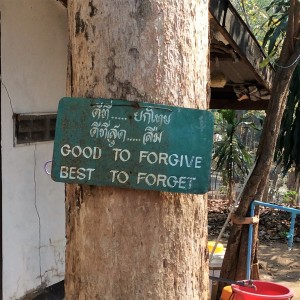 Trees, hedges and rock gardens abound, peopled by Buddhas, boddhisatvas, highly kitsch children, smiley girls, or ditto boys. Attached to trees frequently, in Thai and in English, are maxims, like Peace is the Highest Bliss, or Clean, Clear,
Trees, hedges and rock gardens abound, peopled by Buddhas, boddhisatvas, highly kitsch children, smiley girls, or ditto boys. Attached to trees frequently, in Thai and in English, are maxims, like Peace is the Highest Bliss, or Clean, Clear, 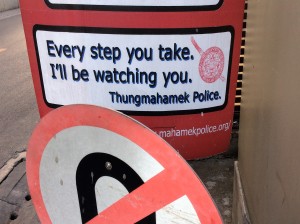 Calm, these are Characteristics of a Noble Person. One Bob so liked he got me to photo and print it was Good to Forgive, Best to Forget. Later in a Bangkok I read Every Step you Take, I’ll be Watching You, which I thought was my guardian angel, but it was only the Thungmahamek
Calm, these are Characteristics of a Noble Person. One Bob so liked he got me to photo and print it was Good to Forgive, Best to Forget. Later in a Bangkok I read Every Step you Take, I’ll be Watching You, which I thought was my guardian angel, but it was only the Thungmahamek 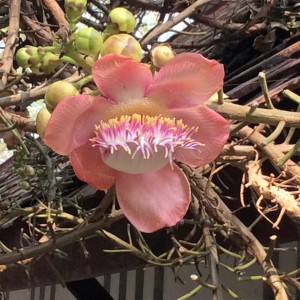 Police.
Police.
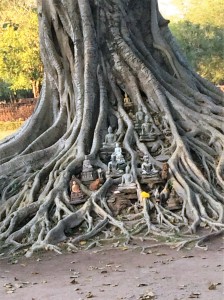 Particularly, I love the way that trees are venerated. Beside the Phrae temple is the most glorious tree, the cannonball tree, each flower like a mouth with a pinky white moustache. But of course the main tree is the baobab, Ficus religiosa with its tapering leaves. Sometimes little Buddha statues are lodged among the intricate branching roots, and trunks are swathed with banners. I understand this path to holiness. Last night I was reading Ekhart Tolle: ‘When you look at a tree and perceive its stillness, you become still yourself. You connect with it at a very deep level. You feel a oneness with whatever you perceive in and through stillness. Feeling the oneness of yourself with all things is true love.’
Particularly, I love the way that trees are venerated. Beside the Phrae temple is the most glorious tree, the cannonball tree, each flower like a mouth with a pinky white moustache. But of course the main tree is the baobab, Ficus religiosa with its tapering leaves. Sometimes little Buddha statues are lodged among the intricate branching roots, and trunks are swathed with banners. I understand this path to holiness. Last night I was reading Ekhart Tolle: ‘When you look at a tree and perceive its stillness, you become still yourself. You connect with it at a very deep level. You feel a oneness with whatever you perceive in and through stillness. Feeling the oneness of yourself with all things is true love.’
Copyright Sarah Coles 2018 Privacy Policy Website Design & Creation Forum Media and Design - Alresford